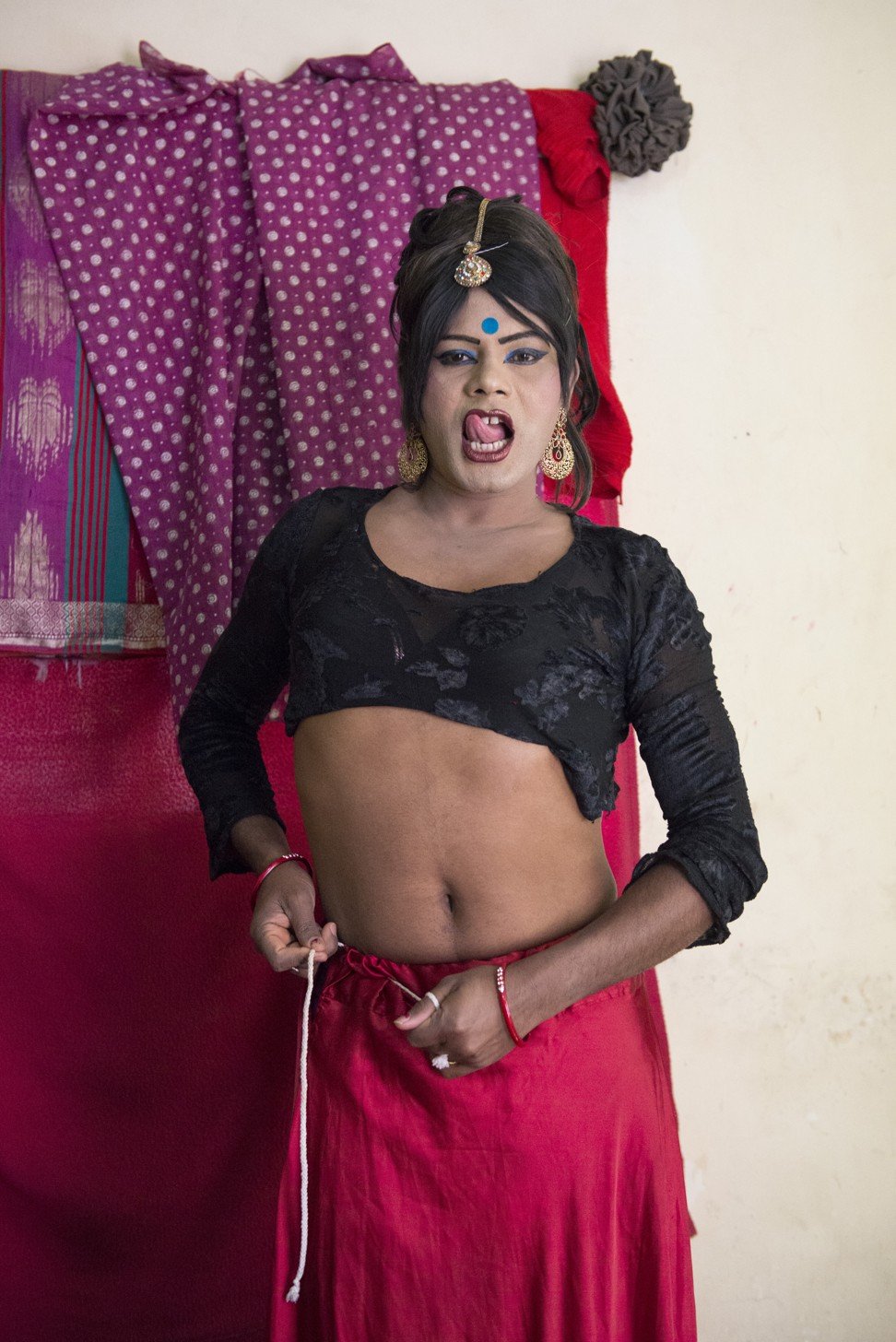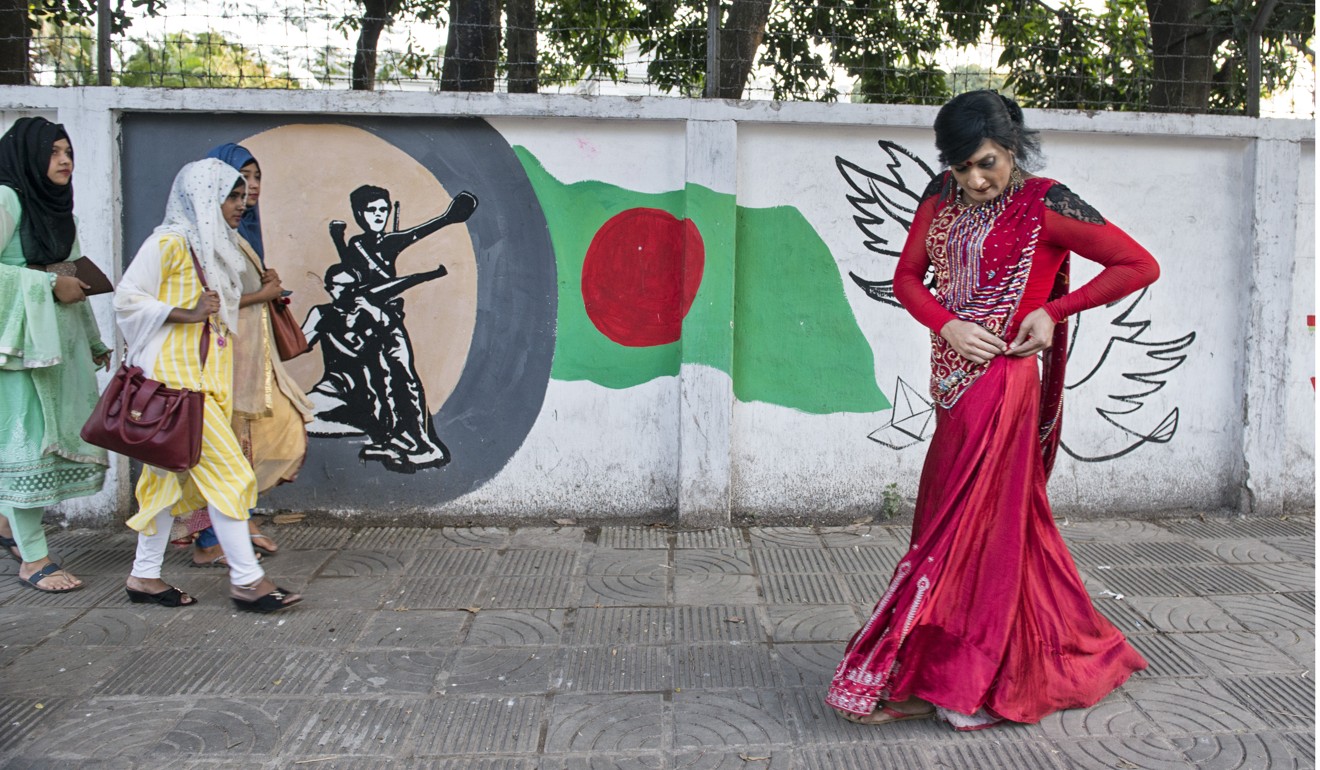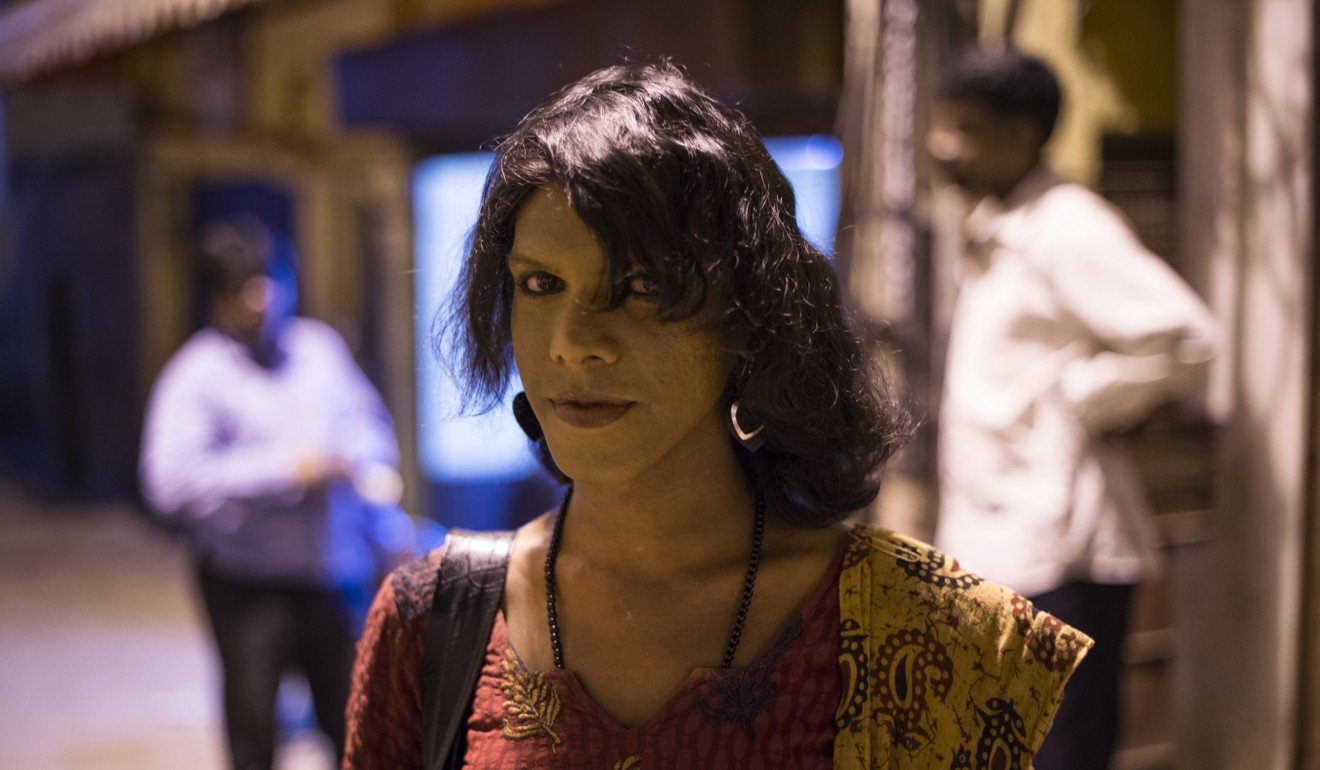
In India, Bangladesh and Nepal, transgender communities exist on margins of society, waiting for change in public opinion
- Transgender rights across South Asia are being addressed
- Societal shifts occur more slowly, however, and discrimination remains a daily reality for the subcontinent’s hijras
Making people uncomfortable is easy for Shanta. She just needs to stand in front of them for a few seconds. She may spend 30 minutes putting on her make-up, don a long gown and a hijab, but most of her fellow Bangladeshis still consider her a man.
“We live in a traditional, religious society,” she says, collecting a 10 taka (90 HK cents) note from a blushing young couple sitting under a tree in the capital, Dhaka. “No one wants to be shamed in public, so they give us money to go away.”
Those who look away, or try to resist, are in for a nice big hug. A sure-fire wallet opener.
“People now deign to call us ‘third-gender,’” Shanta says later, climbing the narrow stairs to her cramped attic apartment shared with four other hijras – the most common term in South Asia for transgender or intersex people. “But still, nobody would rent us a nice place, so we have to stay in this s**thole.”

Sagorika, at 40 the eldest of the group, speaks with a husky voice: “The constitution says we’re all equal but that’s a lie. My former colleagues would call me a faggot and refuse to eat at the same table as me.”
Until the British arrived in the 19th century, hijras were accepted members of South Asian societies, from the flood plains of South India to the heights of the Himalayas.
Mentioned prominently in ancient Sanskrit epics the Mahabharata and the Ramayana, transgender people were the only ones awaiting exiled Lord Rama in the woods after his kingdom fell apart. They stayed on with the giant of Hindu mythology for 14 years, earning the right to perform rituals at sacred ceremonies.
Even the Kama Sutramakes space for hijras.
And while the British have long since left, transgender people across South Asia face their own particular sets of issues and challenges.
The Dhaka roommates will soon be busy preparing for the wedding of a couple they’ve never met. They will arrive at the venue to give their blessings, dance, and get paid for the spectacle.

“I know it’s strange,” says Sagorika. “On the one hand, society rejects us; on the other hand, many people are superstitious and believe we bring them good luck, so they pay to have us perform at their ceremonies.”
The Department of Social Services claims there are about 10,000 transgender people in Bangladesh, but activists and non-governmental organisations say the true figure is closer to 100,000. On January 26, 2014, the Bangladesh cabinet announced the recognition of the third gender as “hijra sex”, but it wasn’t until last April that transgenders were enrolled as voters.
Human Rights Watch (HRW), though, says the country “does not have a policy outlining the measures individuals must take to legally change the gender marker on their official documents from ‘male’ to ‘hijra’, and there is no clarity about who qualifies as such. Absent such guidelines, officials involved in implementing the ‘hijra’ circular have acted on their personal understandings of what ‘hijra’ means.”
I thought that if I was going to be raped anyway, better to get paid for it
This has led to the atrocious humiliation of those trying to land the jobs the government allotted to hijras after the recognition of the third gender. Required to undergo thorough medical examinations to determine whether they are “real” hijras or just desperate jobseekers looking to take advantage of their quotas, HRW documented cases where “physicians ordered non-medical hospital staff such as custodians to touch the ‘hijras’ genitals while groups of staff and other patients observed and jeered, sometimes in private rooms, sometimes in public spaces”.
“You pretend not to care,” says Shanta, “but it weighs heavy in the heart.”
Under Section 377 of Bangladesh’s penal code – also 377 in neighbouring India – enacted by the British colonial government in the 1860s, homosexuality remains illegal.
“We’re legally considered men,” explains Sagorika. “When we go to the mosque we dress as men [...] But if we have sex with other men we can be jailed for life.”

Shanta was born 30 years ago, in Dhaka, and says, “I guess I was normal until the age of seven. Then I started to speak like a girl. My teachers would hit me in the belly and pull my ears, demanding that I speak like a boy, but I didn’t seem to know how. Even if I tried to make my voice deeper, it would come out high-pitched.
“Men would follow me, saying that I was beautiful, but I didn’t know what sexuality was back then. At 15, I got a job at a mechanic shop. Male workers would tease me, and one of them raped me. He told colleagues, and they would blackmail me into having sex with them or they would tell the boss.”
Eventually, her employer discovered what was happening, but accused Shanta of indecent behaviour. She was fired and her family disowned her.
“By then I had grown to like men, and to dress like the woman I feel I am. So I became interested in the hijra community. I went to the Parliament area to meet with them and I started to offer sex services. I thought that if I was going to be raped anyway, better to get paid for it.”

Article 86 of the Dhaka Metropolitan Police Ordinance describes the “Penalty for being found under suspicious circumstances between sunset and sunrise”, which allows for the arrest of anyone “having without any satisfactory excuse their face covered or otherwise disguised”.
According to a 2015 report by the French Office for Protection of Refugees and Stateless Persons, this ordinance is often used against hijras because they wear heavy make-up and women’s clothes at night.
“Policemen often demand sexual services or bribes to let us go,” says Akhi, 28. “We charge only 100 to 500 taka per customer, so we live in constant fear of the police.”
“Maybe laws and regulations will improve,” says Sagorika, “but society doesn’t. I wish we were more like India. Many Bangladeshi hijras flee to India because they can’t take the humiliation here any more.”

“Criminalising carnal intercourse under section 377 of the Indian penal code is irrational, indefensible and manifestly arbitrary,” said chief justice Dipak Misra.
Like many other activists, Asmita Basu, programmes director of Amnesty International India, cheered. “This judgment closes the door on a dark chapter of Indian history,” she wrote in a statement. “It marks a new era of equality for millions of people in India.”
Veena S, the first transgender woman to contest an election in southern India (at the 2010 local polls in Bangalore), says that all these steps forward, although laudable and necessary, are not enough to change attitudes. She refers to a 2006 opinion poll in which 64 per cent of Indians said that homosexuality was never justified, and 41 per cent admitted that they wouldn’t like to have an LGBT neighbour.
“Discrimination has been erased from the law, but social stigma remains,” she says.

Veena underwent sex reassignment surgery in 1997 and a decade later was among the first in India to officially change her gender from male to female.
“It was a painfully long process. First, I had to change my name to Veena and publicly renounce [my birth name] Vittala. Then, because I have a prostate and no uterus, I was labelled a ‘transgender woman’ in my sex certificate. That was enough to get my passport changed to female, and I’m glad that people can now opt for the third gender, but that’s just the start of our fight.”
Tamana, a 30-something hijra who identifies as a bisexual man, living in Bangalore, believes change should also come from inside the community: “I was attracted to the hijra community because I had nowhere to go when my family discovered that I felt like a woman and had sex with men,” he says. “I was only 15 and they sheltered me. But, even though we always pretend to be a family, the truth is that we follow orders from a guru who can be despotic.”

Tamana says he was forced to sell sex and undergo a castration procedure.
“At first they just pushed me to beg in the streets. Then it was prostitution. Finally, they warned me I would only be protected if I went under the knife to become a eunuch.” Out of fear, he agreed. “India has enacted laws to protect us. But society is brutal. My family doesn’t talk to me, and I have no friends outside the hijra circle. I wouldn’t survive on my own.”
Tamana gives half his earnings to his guru, who also overcharges for accommodation in a flat shared with six other hijras. “They are untouchable and create a mafia from which it’s almost impossible to escape,” he says.
Other transgenders were not keen to criticise their gurus, but admitted they are heavy handed and demand a take of their earnings. Of about half a dozen gurus in Bangalore and Delhi, only Kalawati was willing to speak on the record. She is in charge of 20 “disciples”, but denies being a pimp: “I have a respectable life. I don’t want the third gender to be linked to prostitution,” she says.

But Kalawati, a transgender woman herself, admits she uses the hijras under her protection to beg, and takes a cut of their earnings. “Forget what the law says. We are barred from decent jobs, so that’s our only way to survive,” she says.
Rakshita, 27, doesn’t want to have anything to do with the hijra communities. She is a transgender woman in Delhi and proudly underlines that, unlike most, she graduated from university.
“I was born a man but I had my sex reassignment surgery, and I am now 100 per cent woman. I have no identity issues, nor problems with my family.”
Not many transgenders in South Asia can lead what society considers to be a normal life. But Naaz, another transgender woman from Delhi, is proof that it’s possible. She married a man at age 22.
“I was 18 when I met Arian. From the beginning, I was honest and I told him that I was born a man and had no female attributes yet,” she recalls.
“I won’t deny that I was surprised, but I decided to keep seeing her,” replies Arian.

The couple fell in love but many mocked their relationship. “Once a group of people was insulting us and Arian couldn’t take it any more. He cut his hand and painted the bindi [a dot between the eyebrows that signifies love and can denote that a woman is married] with his own blood. This is how he asked me to marry him,” says Naaz, tears welling in her eyes as Arian blushes.
It wasn’t easy, but both families agreed to their marriage and Naaz gathered 300,000 rupees (US$4,360) for her transition. She received hormone therapy and breast implants, and then underwent a penile inversion vaginoplasty. “After so much suffering in my life, I was surprised at how much support I got from family and friends,” she says. “Now that I’ve changed my gender, we are looking at adopting a baby.”
Further north, high in the Himalayas, LGBT rights have arguably advanced more than anywhere else in the region.
Nepal recognised a third gender in 2007, a year after a democracy movement turned the kingdom into a republic. The Supreme Court ordered the government to scrap all laws that discriminated on the basis of sexual orientation or gender identity, and both homosexuality and gender reassignment became legal. Articles 12, 18 and 42 of the new, 2015 constitution – considered among the most progressive in Asia – explicitly protect the LGBT community.

In fact, Nepal is now the only country in the region with a relatively high score on Equaldex – an equality index that compares LGBT rights and public opinion data between countries, states and regions – far higher than the Maldives, Pakistan and Bhutan, as well as middling India.
“On paper we are well ahead of neighbours like India or Bangladesh,” says Pinky Gurung, founder of the Blue Diamond Society, the main LGBT-rights organisation in the country. “But in real life discrimination still persists. Finding a job or even renting a home is difficult for third-gender people. Implementation of the law is still weak.”
Pinky, who understood she was a woman in a man’s body when she met transgenders in Kathmandu’s red-light district, points out that while gender change is allowed, “surgery is required, and sex reassignment procedures are illegal in Nepal. People must travel to India or Thailand, and because they are usually poor, that’s hard to achieve.”

Elyn Bhandari, 27, is a good example of that. He was born female and, at the age of 13, found that his body wasn’t in sync with his mind. “I began to feel bad about myself when my breasts started to grow and I got my first period. I felt like a man and couldn’t understand why I was a woman,” recalls Elyn, born Elina.
It’s been only 20 days since he had surgery to remove his breasts and he is still wrapped in bandages. “It cost me 200,000 rupees. A small fortune,” he says. He would like to undergo genital surgery, too. But “that would be too expensive”, and he is also worried about the result: “Ninety-eight per cent of those who have the procedure are not fully satisfied.”
For now, hormones to grow facial hair and build muscle mass, deepen the voice and stop menstruation are enough. “When people see me in the street, they see a man,” he says. But having a woman accept him as such is more difficult. “I had a relationship once, but her family didn’t accept me and we had to break up. I feel more comfortable with trans women because we share similar difficulties.”

Aakanshya Timsina, another Blue Diamond Society activist, is one of those he has befriended. She had full sex reassignment surgery in Bangkok and now introduces herself as a heterosexual woman. “Another reason many fear to go through the whole surgical procedure is that recovery takes three to four months. It’s time people can’t work and adds to the economic burden,” she explains.
This is also what discourages Meghna Lama from going into the operating theatre to get the vagina she has desired since she was a teenager. “I am too busy to take so much time off,” says the winner of the 2010 Miss Pink Nepal pageant, and owner of the only LGBT bar in Kathmandu, Pink Tiffany.
“That beauty pageant was key in my life for two reasons: first, the press started to show interest in my story, which became a good chance to actively pursue changes in society and brought work opportunities for me; second, that success gave me the courage to start my transition,” says Lama, who once tried to take her own life by drinking poison. Now she is happy to have failed.

With Pink Tiffany, opened in 2015 in the tourist neighbourhood of Thamel (also where many transgenders offer sexual services), Lama wants to provide a safe environment for her people.
But even in relatively progressive Nepal, as in Bangladesh and India, the LGBT community won’t be free until they can be so economically. Their autonomy will grow only with their purchasing power.
Sitting in her bar, ready to welcome the evening’s guests, Lama smiles. “I want to prove that we can be successful in business, too.”

